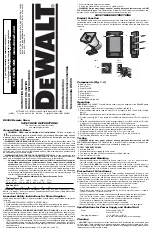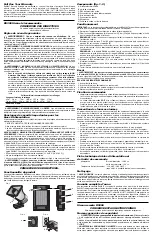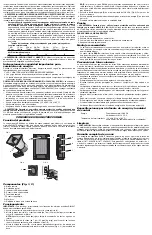
• Do not immerse in water or other liquids.
• Ensure
the
Remote Siren is secured to a stable surface.
WARNING: Always wear proper personal hearing protection that conforms to ANSI
S12.6 (S3.19) during use.
This Remote Siren is rated at 113 dB. Under some conditions and
duration of use, noise from this product may contribute to hearing loss.
SAVE THESE INSTRUCTIONS
Product Function
The DS390 Remote Siren is a wired siren solution to be used with a D
E
WALT Alarm System. It
receives the alarm sound from the base unit through an internal microphone and turns on the
Remote Siren in the event of an alarm. It will discontinue alarming when the base unit stops
alarming.
A
FIG. 1
C
D
F
G
B
H
E
FIG. 2
FIG. 3
Components (Fig. 1, 2)
A. Remote Siren
B. Control Unit
C. Power On LED
D. Remote Siren Connector
E. Power Supply
F. Power Connector
G. Microphone
H. Siren Grille on Base Unit
Operation
IMPORTANT:
The D
E
WALT Portable Alarm's siren(s) must be enabled for the DS390 Remote
Siren to function properly.
1. Determine an outdoor location for placement of the Remote Siren (A).
2. Mount the Remote Siren (A) and run wire [25' (7.6 m) length] to the Control Unit (B), located
indoors.
NOTE:
Aim the siren downward to limit rain/water from building up inside.
3. Plug the siren wire [25' (7.6 m) length] into the Remote Siren Connector (D) on Control Unit
(B).
4. Using the self-adhesive hook and loop pieces (provided), mount the Control Unit (B) so the
microphone (G) is directly over the siren grille (Fig. 2, H) on the base unit.
NOTE:
If using the DS500, mount the self-adhesive hook and loop pieces over the speaker
grill. If using the DS100, position the base unit with the keypad facing you. Mount the self-
adhesive hook and loop pieces over the speaker grille on the left side.
5. Plug power supply (E) into 120 V AC power (Fig. 3). For indoor use only.
6. Plug power supply output cord into the power connector (F) on the Control Unit.
7. Test alarm by initiating an alarm on the base unit.
Testing
WARNING: Always wear proper personal hearing protection that conforms to ANSI
S12.6 (S3.19) during use.
This Remote Siren is rated at 113 dB. Under some conditions and
duration of use, noise from this product may contribute to hearing loss.
TO TEST THE REMOTE SIREN
1. Arm the base unit.
2. Activate the alarm by tripping an active sensor.
3. The alarm on the base unit will sound and start the Remote Siren.
4. Turn the system off to stop.
Recommended Mounting
• Recommended location for the Remote Siren is outdoors (i.e., on a roof, below a trailer, a
flat solid surface) to provide notification throughout the outdoor environment.
• The Remote Siren
MUST
be mounted securely on flat, solid surface to ensure product is
not damaged and will work properly. Predrilled mounting holes are located on the mounting
bracket. Position the horn downward to limit rain from building up inside.
Prevention of False Alarms
The majority of alarms that occur are false. These situations happen every day due to user
error, incorrect installation or improper maintenance of the system. False alarms will limit the
responsiveness to the system and become a general inconvenience. As the number of false
alarms increases, authorities have become less apt to respond to alarm systems due to this
problem. Many of these situations can be avoided by following some very simple practices.
• Ensure all users are properly trained on the operation of the alarm system.
• Always turn off the alarm system before entering protected area.
• Lock all protected doors, windows or any other asset attached to a sensor.
• Check that motion detector is not obstructed. Do not allow sources of heat or sound in
range of the motion or vibration sensors.
• Check that premises are cleared and assets secured before arming the security system.
• Turn off all noise sources – radios, compressors, generators, heavy equipment, etc.
• Know how to cancel an alarm or turn off the security system before activating.
• If a false alarm is tripped notify customer service immediately.
• Test the system on a monthly basis to ensure proper functioning.
• Check cellular signal, power supply and that sensors are secured on a daily basis.
Specifications for Power Supply and Control Unit
Power
Power supply: 120 V AC
Control Unit: 12 V DC
Operating temperature
-12˚ to 40˚C (10˚ to 105˚F)
up to 90% relative humidity (non-condensing)
Cleaning
CAUTION:
Never use solvents or other harsh chemicals for cleaning the non-metallic parts
of the product. These chemicals may weaken the plastic materials used in these parts. Use a
cloth dampened only with water and mild soap. Never let any liquid get inside the product; never
immerse any part of the tool into a liquid.
INSTR
UCTION MANU
AL
GUIDE D'UTILISA
TION
MANU
AL DE INSTR
UCCIONES
INSTR
UCTIV
O DE OPERA
CIÓN, CENTR
OS DE SER
VICIO
Y PÓLIZA
DE GARANTÍA.
AD
VER
TENCIA:
LÉASE ESTE INSTR
UCTIV
O ANTES
DE USAR EL PR
ODUCT
O
.
DS390 Remote Siren
DS390 Sirène télécommandée
Sirena remota DS390
If y
ou ha
ve questions or comments,
contact us.
P
o
ur toute question ou tout commentaire
, nous contacter
.
Si tiene dudas o comentarios,
contáctenos.
1-877-SITELOCK • www
.dewalt.com
DS390 Remote Siren
SAVE THESE INSTRUCTIONS
This manual contains important safety
and operating instructions.
General Safety Rules
WARNING: Read and understand all instructions.
Failure to follow all
instructions may result in electric shock, fire, property damage and/or serious
personal injury or death. In addition, read and follow all instructions and warnings
provided with your
D
E
WALT
alarm system.
WARNING: SERIOUS INJURY OR DEATH.
Do not use this system in hazardous areas. This
may include blasting areas and potentially explosive atmospheres. Sparks in such areas could
cause an explosion or fire resulting in bodily injury or even death. They include but are not limited
to fueling areas such as gas stations; fuel or chemical transfer or storage facilities; vehicles using
liquefied petroleum gas (such as propane or butane); areas where the air contains chemicals or
particles, such as grain, dust, or metal powders; and any other area where one would normally
be advised to turn off a vehicle engine.
WARNING: FIRE, ELECTRIC SHOCK OR ELECTROCUTION.
Do not use an extension cord
unless it is absolutely necessary. Use of an improper extension cord or an extension cord that has
been worn or damaged could result in risk of fire, electric shock, or electrocution.
• An extension cord must have adequate wire size (AWG or American Wire Gauge) for
safety. When operating your system outdoors, use an extension cord suitable for
outdoor use.
Use of a cord suitable for outdoor use reduces the risk of electric shock.
When using an extension cord, be sure to use one heavy enough to carry the current your
product will draw. An undersized cord will cause a drop in line voltage resulting in loss
of power and overheating. The following table shows the correct size to use depending
on cord length and nameplate ampere rating. If in doubt, use the next heavier gage. The
smaller the gage number, the heavier the cord.
Recommended Minimum Wire Size for Extension Cords
Total Length of Cord
25 ft.
50 ft.
75 ft.
100 ft.
125 ft. 150 ft.
175 ft.
7.6 m 15.2 m
22.9 m 30.5 m 38.1 m 45.7 m 53.3 m
Wire Size AWG
18 18 16 16 14 14
12
WARNING: SERIOUS INJURY OR DEATH.
When using any type of elevating or lifting
device (i.e., ladder), be sure to read and understand the manual and all safety precautions
associated with that equipment.
Important Safety Instructions for Power Supplies
When using electrical products, basic precautions should always be practiced including the
following:
1. READ AND FOLLOW ALL SAFETY INSTRUCTIONS.
2. Read and follow all instructions that are on the product or provided with the product.
3. The power supply and fixtures must be installed to meet all National and local codes and
ordinances.
CAUTION: POTENTIAL EQUIPMENT MALFUNCTION OR FAILURE.
Use only the power
supply provided with this equipment. Do not operate with a damaged power supply cord or
plug. Protect the cord from being walked on or pinched. Do not pull on cords or cables. When
unplugging the cord from an electrical outlet, grasp and pull the cord by the plug. If the cord is
missing or damaged, contact D
E
WALT (1-800-4-D
E
WALT) for a replacement power supply.
• This product is not user serviceable. There are no user serviceable parts inside this product.
Do not attempt to open housing to access internal components. Servicing at a D
E
WALT
authorized service center is required to avoid damage to product. Unauthorized service will
void the warranty.
• Avoid exposure to temperature extremes [-12˚ to 40˚C (10˚ to 105˚F)].
SITELOCK LLC, 701 East Joppa Road, Baltimore, MD 21286
(JAN07) Form No. 644514-00 DS390 Copyright © 2006, 2007 D
E
WALT





















